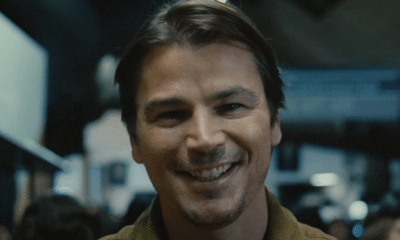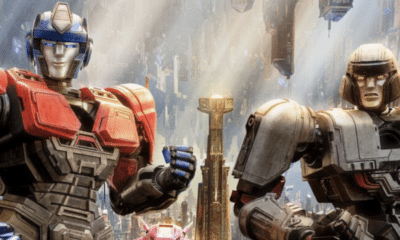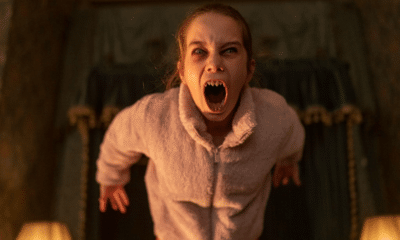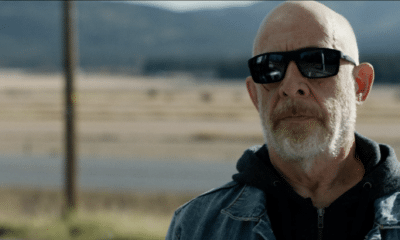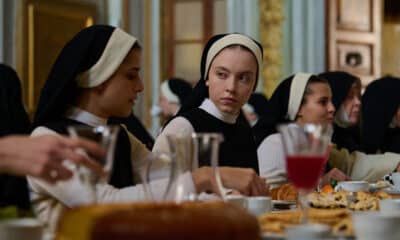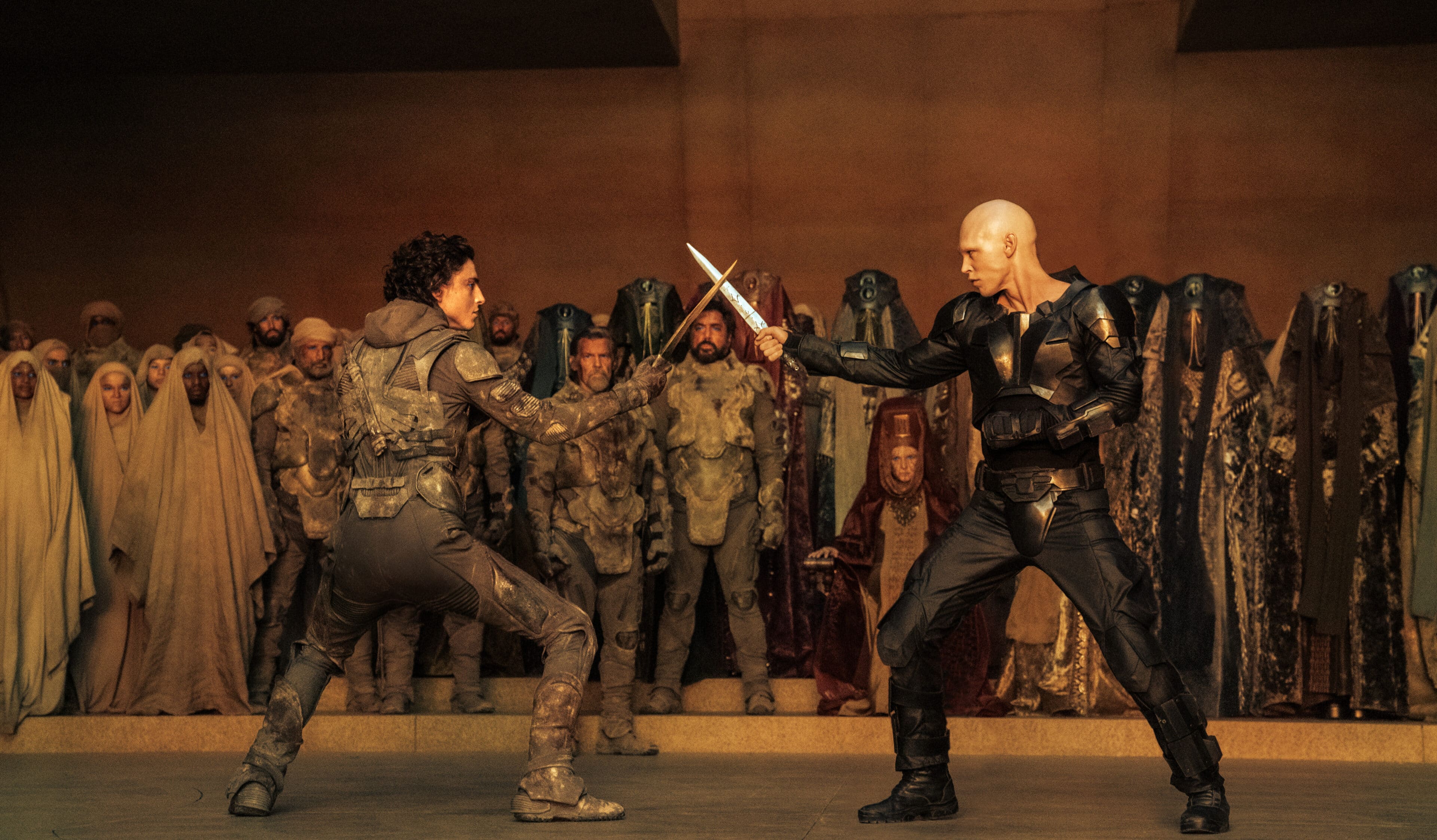Directed by Gary Trousdale and Kirk Wise.
1996/91 minutes
Perhaps the darkest film for the Disney 53, and certainly of the Renaissance period, THE HUNCHBACK OF NOTRE DAME was the first to focus on a major religion, and led to some controversy during production, mostly due to the heavy subject matter. There were many issues that caused friction between the creative team and the studio, notably the character of Frollo, his profession and motivation.
Like many/most of Disney’s adaptations, THE HUNCHBACK OF NOTRE DAME is considerably lighter, and somewhat happier than Victor Hugo’s original novel, but its themes of religion, racism, moral and social commentary and the rights of all peoples to exist in peace remain firmly in place.
SYNOPSIS: Paris, the fifteenth century; the kindly, deformed Quasimodo lives a lonely existence within the belltower of Notre Dame cathedral. His only living companions are a trio of stone Grotesques (not Gargoyles, and their being “alive” is debatable), and Judge Claude Frollo, a powerful man who seeks to purge the city of Gypsies. Unknown to Quasimodo, Frollo killed his mother in cold blood when she tried to enter Paris illegally, carrying the infant Quasi as a baby; the timely arrival of the Archdeacon, and the threat of eternal damnation stays Frollo’s hand, and he vowed to care for the child as though he were his own son.
Frollo’s parenting techniques are dubious at best; he verbally and emotionally torments the boy, forbidding him to venture beyond the Cathedral, where he will find only fear and hatred. Quasi dreams of life beyond the Cathedral, and the day happens to be the Feast of Fools, a city-wide wild party that celebrates the absurd and the grotesque.
At the same time, Captain Phoebus returns to Paris after some considerable time away at war; he’s here at Frollo’s command, to aid the Judge in purging Paris of all Gypsies, and their “heathen magic”. By chance, Phoebus has already come to the aid of a Gypsy woman, Esmeralda, from Frollo’s brutish city guards.
Sneaking off to enjoy himself, Quasimodo is discovered, and crowned the King of Fools and is celebrated for his absurdity, but his euphoria turns to horror, as Frollo’s troops – little more than thugs – incite a riot. Bound and humiliated, Quasimodo screams for help from Frollo, who does nothing, despite Phoebus’ protests. Only Esmeralda shows him any compassion, cutting him free in defiance of Frollo’s orders. Inciting the people against him, Esmeralda escapes the guards and enters Notre Dame to find Quasimodo, only to be followed by Phoebus. The Captain claims sanctuary on her behalf, saving her life but confining her to the cathedral.
Esmeralda finds Quasimodo and befriends him; in gratitude for her own kindness, he helps her escape Notre Dame. Before she vanishes into the night, she entrusts him with a pendant with a hidden map to the Court of Miracles, a Gypsy hideout that Frollo has hunted for some time.
While Quasimodo basks in the light of Esmeralda’s kindness, Frollo begins to succumb to his own lustful interests, begging the Virgin Mary for her aid in escaping the “dark spell” that has him so enraptured.
Upon discovering Esmeralda’s escape, Frollo begins a city wide man hunt, taking ever more drastic steps to find her, culminating in the burning of a homestead with a family within as a lesson to others. Seeing that Frollo has gone too far, Phoebus defies him, rescuing the family from the flames, an act witnessed by Esmeralda, who comes to his rescue after his is shot and falls into a river, taking him to Quasimodo for refuge. It’s here that Quasimodo realises Esmeralda’s heart lies with Phoebus, breaking his own in the process.
By this point, Frollo has managed to put two and two together and realised that Quasimodo aided Esmeralda’s escape. After informing Quasimodo of his uncovering the Court’s location, Quasi and Phoebus manage to put aside their differences, decipher the map and reach the Court of Miracles…only to lead Frollo and his men right to it.
With the Gypsies of Paris under lock and key, and Quasimodo chained to the pillars atop Notre Dame, Frollo prepares to burn Esmeralda at the stake after refusing his advances. Inspired by the Grotesques, Quasimodo breaks free of his chains and saves Esmeralda from the fire, carrying her to the top of the cathedral. Phoebus manages to free himself and the Gypsies, and rallies the people of Paris against Frollo and his guard.
In the ensuing conflict, Frollo makes one last attempt at Esmeralda’s life, before he and Quasimodo fall from the parapets. Frollo falls to his death while Quasi is caught by Phoebus.
Accepting Esmeralda and Phoebus’ love for each other, he blesses their union, and at their encouragement, leaves the cathedral. The people of Paris hail him as a hero and accept him into society, as his Grotesque guardians watch proudly from above.
Lessons learned:
1. Don’t judge people by appearances.
2. Religion and faith aren’t the answer to everything.
3. Evil comes in many guises, and so does Goodness.
The Heroes
![]()
Quasimodo, voice of Tom Hulce, is in many ways the archetypal gentle giant, possessing superhuman strength tempered with a kind and innocent heart. Knowing nothing of the world beyond the Cathedral’s walls, his one source of knowledge is Frollo, who naturally twists the facts to suit his own worldview.
By contrast, Captain Phoebus, voiced by Kevin Kline, couldn’t be more the classic hero. He’s a master swordsman with a wit as sharp as his blade, willing to put his career and his life on the line to do the right thing. He’s a change from the usual Disney hero in that he’s not shown to be a strapping, fresh-faced young man, but a veteran soldier with several decades’ experience. He also sports a beard, not seen on a Disney hero before, or until Flynn Rider.
They have the classic antagonistic friendship; both of them love Esmeralda, and both think the other isn’t worthy of her, but they’re able to settle some differences whilst retaining a healthy banter.
The Heroines
![]()
Demi Moore voices Esmeralda (singing voice by Heidi Mollenhauer), a Gypsy woman and central McGuffin; she provides the catalyst for much of the action, as Quasimodo, Frollo and Phoebus all fall for her. In effect, she’s a female Aladdin; surviving on her wits, persecuted by morally ambiguous lawmen, animal sidekick who’s as smart as anyone else in the room. She’s the first person to show Quasimodo any real human kindness, and though her heart ultimately belongs to Phoebus, it’s shown that she cares for him deeply.
Following the trend set by Pocahontas, Esmeralda is a strong-willed, independent woman, enough to stand up to Frollo even as her life rests in his hands. And while she fights for herself, her greatest wish is to see her people treated as equals, accepted in society.
But, we’re forgetting another female presence, one integral to the story and perhaps the most influential character; Notre Dame herself.
From the outset, it’s implied that Notre-Dame de Parie is more than stone and glass; after Frollo has killed Quasimodo’s mother and attempts to kill the child himself, he is stopped when the eyes of Notre Dame glare down upon him, and when Frollo falls to his doom, it’s as though the Cathedral itself is killing him, breaking beneath his feet and roaring in venegful triumph at his demise…consider also that the Grotesques befriended by Quasimodo may be aspects of the Cathedral given voice; I’m thinking mostly of Laverne here, the closest thing to a mother Quasi has ever known. What Victor and Hugo represent is a little less easy to discern…perhaps they’re the equivalent of the angel and demon we see on characters’ shoulders, like Kronk.
The Villain
![]()
Judge Claude Frollo, voiced by the late, great Tony Jay. After a small role in BEAUTY AND THE BEAST as Monsier D’Arque, Jay returns in a major role, and wow.
Much like Governor Ratcliffe, Frollo believes he is a good man, and a man of God; all of his actions are in His name, and he cannot be held accountable. He also shares Ratcliffe’s dark, cynical sense of humour and penchant for genocide, embarking on a decades-long quest to rid the city/world of Gypsies.
In fact, Frollo is in many ways the ultimate Disney villain, sharing traits with:
- Lady Tremaine (abusive relation with stepchild, position of power)
- Shere Khan (deep-rooted hatred of humans/Gypsies)
- Scar (manipulating the heroes, after killing a parent)
- Stromboli/ Zira (incarcerating the hero to fulfill a greater goal)
- Gaston/ Jafar (lusting for the heroine whilst abusing their position of power)
- Mother Gothel (“caring” for the hero(ine) whilst using them for their own ends)
Now, in Victor Hugo’s original novel, Frollo was a church official – archdeacon of the cathedral, in fact. Disney reinterpreted him as a judge, outside of the church whilst being devoutly religious, preoccupied with the view of Gypsies as “agents of moral decay”, rather than deviants of the church.
“Disney executives would have no part of Hugo’s intent to criticise the church and its leaders for their failure to defend the poor and the powerless…[it would be] too controversial.”
The Gospel According to Disney
HIS FATE: After attempting (several times) to kill both Esmeralda and Quasimodo, Frollo is thrown from the balcony. Making one last attempt on Quasimodo’s life from atop a gargoyle, it crumbles beneath his feet. As he desperately clings to it, it roars in his face before breaking. Frollo falls into a pool of molten lead, symbolic of his eternal damnation.
Sidekicks and Henchmen
![]()
Now, one could argue that Phoebus and even Quasimodo are henchmen of Frollo, but it’s easier to judge them as Heroes. The rest of the guard in Frollo’s employ are basically mindless, characterless thugs, hired muscle for crowd scenes and slapstick humour.
While Esmeralda is an analogue of Aladdin, Djali is cut from the same cloth as Abu (they even share the same voice artist, Frank Well) in that he’s Esmeralda’s constant companion, partner in crime, confidant…and often one step ahead of everyone else in the room.
Quasimodo on the other hand is guided through life by three animated Grotesques; Victor (the tall, British one, voiced by Charles Kimbrough), Hugo (the short, comic one, voice of Jason Alexander) and Laverne (the tough, motherly one, voiced by Mary Wickes). It’s possible that they only come to life in Quasimodo’s imagination, but as I said above, as things progress it becomes clear that there is something more going on with the architecture of Notre Dame.
Victor and Hugo owe much to Timon and Pumbaa, being the double-act who guide Quasimodo through his formative years and the source of much of the humour in the film, while Laverne (named after the director’s wife) acts as the straight (wo)man, whilst also getting a lot of great material.
Plot
![]()
Whilst being a loose adaptation of the novel (to put it mildly), Disney’s take on THE HUNCHBACK OF NOTRE DAME has a great plot, full of intrigue, unrequited romance, persecution and social commentary, as well as talking stone people. The climax also owes a lot to THE LION KING, what with the hero and villain wrestling over a pit of fire.
The religious iconography is pretty heavy, especially for a Disney film, but it’s an integral part of the story, rather than being forced on us as allegory, while the “Gypsies are people too!” subplot is carefully handled.
Laughs
![]()
Mostly coming from the Grotesques, most of the humour is of the fast-paced dialogue and slapstick variety; Victor and Hugo’s double act, Laverne’s ongoing struggle with the pigeons of Paris (“Don’t you ever migrate!?!”), and the odd pop-culture reference (they can get away with it being timeless, magical creatures akin to the Genie), but Phoebus gets a lot of good material – mostly due to Kevin Kline’s vocal performance, with just the right amount of rapier wit and foot-swallowing faux pas.
And that’s not to mention the Gypsies themselves, most notably Clopin, here re-imagined as a charismatic, sarcastic and rather macabre narrator, providing the framing of the plot. It’s hard to place where Clopin’s true nature lies at times, but he takes his position as leader of the Gypsies of Paris seriously, even if that’s the only thing he does take seriously.
Scares
![]()
THE HUNCHBACK OF NOTRE DAME is perhaps the darkest animated film Disney has ever made. Whilst being a beacon of hope, Notre Dame is shown to be a harsh, forbidding place, full of character, and the horrors seen within and around its walls are amongst the darkest of any mainstream animated movie. It features a violent, shocking death in the first five minutes, and a barely-halted infanticide moments later.
Very much the dark heart of the film, Frollo’s descent into madness and genocide is terrifying in its believability, and the fact that he believes in the righteousness of his actions, even as Paris itself burns in his quest to recapture one woman. It’s a chilling moment when Notre Dame herself takes vengeance for his crimes, bringing to mind Scar’s demise, and the hellish symbolism amongst the most powerful of any Disney film.
Moral/Educational value
![]()
While the religious aspects of the story aren’t forced – people on both sides fight and are willing to kill for their beliefs and right to freedom – its message of acceptance, of both the handicapped and of ethic minorities is well-played, much the same as they were in POCAHONTAS.
Quasi and Phoebus provide good role models in their own way while Esmeralda is another in a long line of strong women that kids can look up to.
I dread to think how kids would react to reading the source novel, given its less-than-faithful adaptation here – for one thing, almost everyone lives happily ever after – but if it gets people interested in history, architecture or literature, then job well done, I say.
Music/Songs
![]()
![]()
THE HUNCHBACK OF NOTRE DAME features some truly powerful songs; right from the outset, as Paul Kandel, backed by full choir, introduces the story with “The Bells of Notre Dame”, reprised at the final curtain, and two other songs, “Topsy Turvy” and “The Court of Miracles”, massive numbers that threaten to overpower the film with vibrant light and colour. He’s backed up by the Grotesques’ own number, “A Guy Like You”, full of pop-culture references in the shadow of Robin Williams as the Genie, but these songs serve as counterpoint to the heartfelt ballads at the core of the film; two of them are duets, of sorts, between Quasimodo and Frollo, and each of them is beautiful and powerful in its own way; both “Out There” and “Heaven’s Light/ Hellfire”, as well as showcasing their voice artist’s powerful voices.
But it’s “God Help the Outcasts”, sung by Esmeralda, that stands out for me, as she looks to the Man Upstairs for help, asking was Jesus not an outcast, too, as she sees firsthand how her people, and Quasimodo, are persecuted for their differences, praying for the downtrodden while the rich, established citizens pray for wealth, fame and glory. It’s a powerfully quiet song (given its singer’s location), performed admirably by Heidi Mollenhauer.
Legacy
![]()
Several computer games have capitalised on the movie, most recently the KINGDOM HEARTS series, which features a world based upon the film and reuniting most of its cast.
A sequel, THE HUNCHBACK OF NOTRE DAME II, picks the story up six years later, and (understandably) has no real bearing in Victor Hugo’s work. Phoebus and Esmeralda are married with a son, Zephyr (voiced by Haley Joel Osment in one of his earliest roles) and Quasimodo finally finds love, in the form of Madellaine…who happens to be in the employ of Sarousch, ringmaster of a travelling circus/gang of thieves, with plans to rob Paris blind and make off with La Fidéle, a jewel-encrusted bell. It’s a relatively simple and sweet story, and the animation quality does drop drastically, but there have been worse Disney sequels.
A stage musical version debuted in 1999 as DER GLOCKER VON NÖTRE DAME, running for three years, becoming one of Berlin’s longest-running musicals. A Broadway version is on the cards, and set to premiere in 2014. It’s considerably closer to the source novel whilst retaining a lot of the musical numbers, and adding a couple more.
FINAL SCORE: 43/53
Next Time: Hercules

Latest Posts
-


Film Trailers
/ 41 mins agoM. Night Shyamalan’s ‘Trap’ trailer lands
Anew experience in the world of M. Night Shyamalan.
By Paul Heath -


Film News
/ 16 hours agoFirst ‘Transformers One’ teaser trailer debuts IN SPACE!
The animated feature film is heading to cinemas this September.
By Paul Heath -


Film Reviews
/ 16 hours ago‘Abigail’ review: Dirs. Matt Bettinelli-Olpin & Tyler Gillett (2024)
Matt Bettinelli-Olpin and Tyler Gillett direct this new horror/ heist hybrid.
By Awais Irfan -


Film Trailers
/ 17 hours agoNew trailer for J.K. Simmons-led ‘You Can’t Run Forever’
A trailer has dropped for You Can’t Run Forever, a new thriller led by...
By Paul Heath

